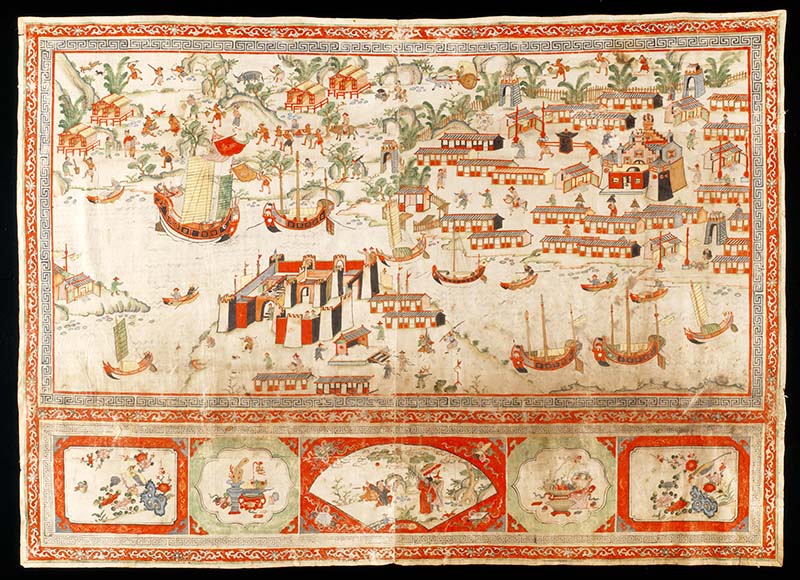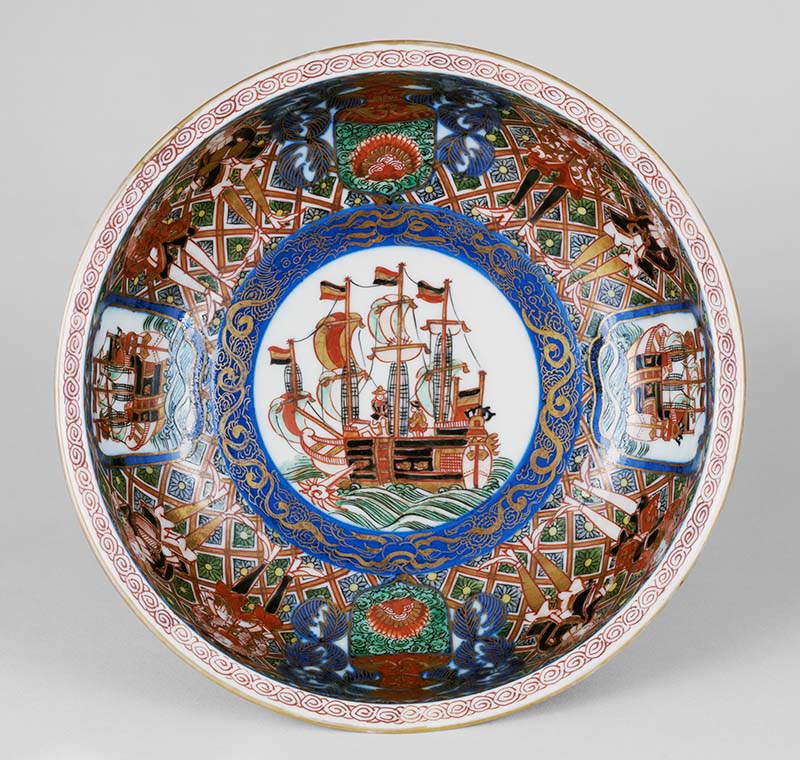Chronicles of a Global East: Seattle Art Museum Exhibition Examines Silk Roads and Maritime Routes
Click on images to enlarge them and view captions.
by Foong Ping
By land and by sea, the premodern global world was deeply interconnected. Chronicles of a Global East, an ongoing exhibition at the Seattle Art Museum, narrates a few of the many stories related to the Silk Roads and maritime routes, where innumerable transnational artistic traditions emerged.
A monumental 18th-century deerskin map (figure 1) on display provides a commanding view of Tainan, a port city in Taiwan. This map (one of three that survive) portrays the region’s geographic, social, and cultural characteristics. The use of leather and the illustration of the city’s two Dutch-built fortresses testify to cultural exchanges between China and the West. Prominent residents of Tainan are carried in litters. Three women go about with half-opened parasols—an emancipated custom of Taiwanese women not enjoyed by their Han Chinese counterparts. A fortune teller announces the Lunar New Year with a message written on a scroll, “Spring is here and enters ten thousand homes.”
In a reversal of Chinoiserie, an imperial late-18th-century reverse-painted mirror (figure 2) shows Chinese palaces set within a pastoral European landscape. The traditional “one hundred boys” subject of this decorative looking glass carries auspicious wishes for fertility and felicity. A boy lifts a lantern with the words, “A Great Age of Peace and Prosperity.” The children celebrate Yuanxiao, the 15th day of the Lunar New Year. Their procession begins on the far shores among European-style houses. Adopting Western painting techniques, the artists show the boys’ reflections on the river and depict the Chinese-style palace buildings as three-dimensional structures. Trade with China was restricted to Canton alone, so most reverse-painted mirrors were made there. Intended for export, they offered romanticized visions of China for the Western viewer, who paid handsomely for them. The reverse is true in the mirror shown in this exhibition: a Chinese festival is situated within a pastoral European landscape, and the usual Oriental fantasy is replaced by an imagined Occidental variant. This mirror’s subject matter and courtly refinement suggest that it was sent from Canton in southern China to the Qing imperial palace as tribute.
The power and presence of the Dutch East India Company in Japan is front and center in a mid-19th-century dish (figure 3), depicting Dutch vessels with Dutch figures, a popular design that first appeared in the 18th century. The company traded in numerous Japanese products, including Imari porcelain, and also dominated the European market for Chinese porcelains in the 17th and early 18th centuries. Images of Europeans in Japanese art proliferated during the Edo period, particularly of the Dutch—komo, or red-haired people—because of their contact with Japan through trade during a time of national isolation. Dutch motifs were in demand to satisfy Japanese curiosity about Western culture.
The blue-and-white ceramics on view (figure 4) recall Chinese porcelains but are in fact inventive Vietnamese commercial wares. The Vietnamese ceramic industry flourished from the 15th century when China’s Ming dynasty closed its ports and banned exports. Vietnam’s potters made high-fired stoneware for domestic use and export with cobalt underglaze decoration and often with forms and motifs without Chinese equivalent. The village of Chu Dao was a prolific center of production and innovation for several centuries, and their wares reached Japan and as far west as Turkey and Egypt. This exhibition features over 30 Chu Dao examples from the 250,000 pieces recovered from a shipwreck near the port of Hoi An.
These are but a few of the dozens of fascinating objects that make up Chronicles of a Global East. Each appropriation represents a claim of advantage—whether over strategic territory, in artistic and technological sophistication, or business innovation. Each also embodies curiosity, a desire for new knowledge through borrowing from the unfamiliar other.
Dr. Foong Ping is the Foster Foundation Curator of Chinese Art at the Seattle Art Museum. Chronicles of a Global Eastis made possible with support from Taiwan Studies Arts & Culture Program, University of Washington; the University of Washington East Asia Center; and Lucie Tuan in honor of Yuyann Hu and Enlei Tuan.
A print version of this article was published in The Magazine of the Decorative Arts Trust, one of our most popular member benefits. Join today!




